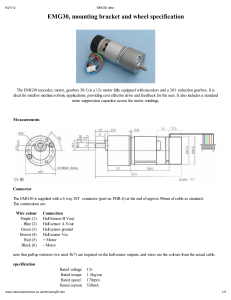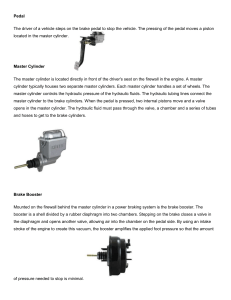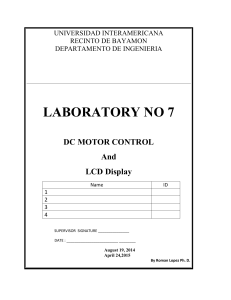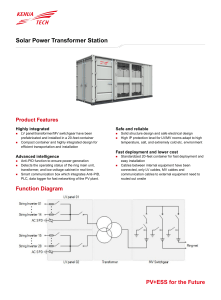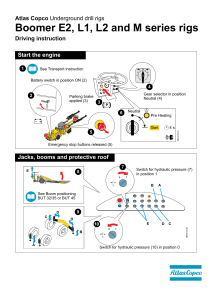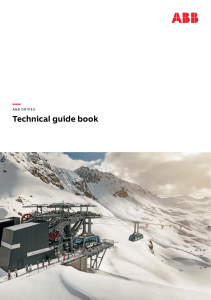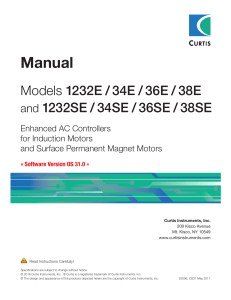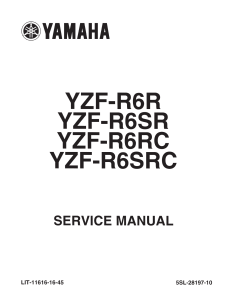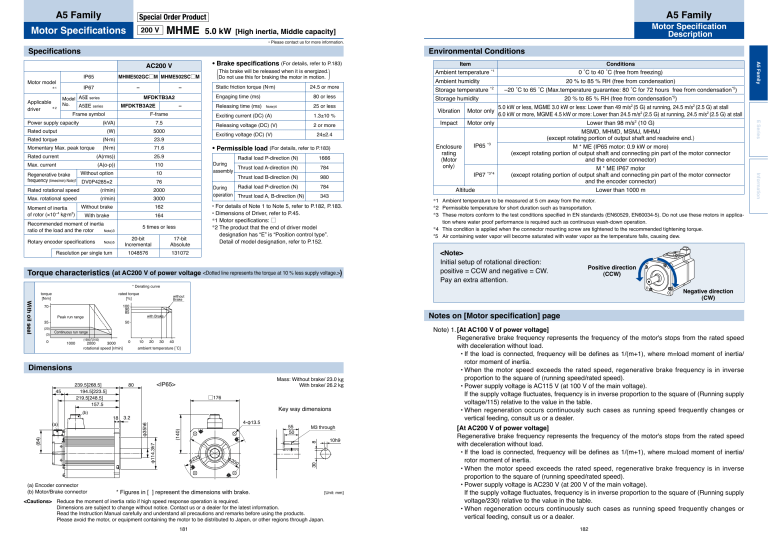
A5 Family Motor Specifications MHME 200 V A5 Family • Please contact us for more information. Specifications MHME502GC□M MHME502SC□M IP65 Motor model – IP67 *1 MFDKTB3A2E Frame symbol 7.5 Rated output (W) 5000 Rated torque (N•m) 23.9 Momentary Max. peak torque (N•m) 71.6 Rated current (A(rms)) 25.9 Max. current (A(o-p)) 110 2000 Max. rotational speed (r/min) 3000 Without brake 162 With brake 164 Recommended moment of inertia Note)3 ratio of the load and the rotor Rotary encoder specifications Resolution per single turn 1.3±10 % Releasing voltage (DC) (V) 2 or more 20-bit Incremental 17-bit Absolute 1048576 131072 Radial load P-direction (N) During Thrust load A-direction (N) assembly Thrust load B-direction (N) 1666 Radial load P-direction (N) During operation Thrust load A, B-direction (N) 784 784 980 * Derating curve With oil seal rated torque [%] 35 (20) (3) Peak run range 1000 (1900) (2100) 0 10 20 30 40 ambient temperature [˚C] Dimensions (a) Encoder connector (b) Motor/Brake connector Key way dimensions 3.2 4-φ13.5 M3 through 10h9 8 55 50 33 φ2 φ2 00 * Figures in [ ] represent the dimensions with brake. 30 18 (140) (84) (a) □176 φ35h6 (b) Mass: Without brake/ 23.0 kg With brake/ 26.2 kg <IP65> 80 φ114.3h7 45 239.5[268.5] 194.5[223.5] 219.5[248.5] 157.5 Motor only Impact Motor only Enclosure rating (Motor only) IP65 *3 IP67 *3*4 5.0 kW or less, MGME 3.0 kW or less: Lower than 49 m/s2 (5 G) at running, 24.5 m/s2 (2.5 G) at stall 6.0 kW or more, MGME 4.5 kW or more: Lower than 24.5 m/s2 (2.5 G) at running, 24.5 m/s2 (2.5 G) at stall Lower than 98 m/s2 (10 G) MSMD, MHMD, MSMJ, MHMJ (except rotating portion of output shaft and readwire end.) M * ME (IP65 motor: 0.9 kW or more) (except rotating portion of output shaft and connecting pin part of the motor connector and the encoder connector) M * ME IP67 motor (except rotating portion of output shaft and connecting pin part of the motor connector and the encoder connector) Lower than 1000 m *1 Ambient temperature to be measured at 5 cm away from the motor. *2 Permissible temperature for short duration such as transportation. *3 These motors conform to the test conditions specified in EN standards (EN60529, EN60034-5). Do not use these motors in application where water proof performance is required such as continuous wash-down operation. *4 This condition is applied when the connector mounting screw are tightened to the recommended tightening torque. *5 Air containing water vapor will become saturated with water vapor as the temperature falls, causing dew. <Note> Initial setup of rotational direction: positive = CCW and negative = CW. Pay an extra attention. Positive direction (CCW) Notes on [Motor specification] page with Brake 50 2000 3000 rotational speed [r/min] Vibration 20 % to 85 % RH (free from condensation*5) Negative direction (CW) Continuous run range 0 Storage humidity 20 % to 85 % RH (free from condensation) –20 ˚C to 65 ˚C (Max.temperature guarantee: 80 ˚C for 72 hours free from condensation*5) without Brake 100 90 85 70 Storage temperature *2 Altitude 343 Torque characteristics (at AC200 V of power voltage <Dotted line represents the torque at 10 % less supply voltage.>) torque [N•m] Ambient humidity 24±2.4 • For details of Note 1 to Note 5, refer to P.182, P.183. • Dimensions of Driver, refer to P.45. *1 Motor specifications: □ *2 The product that the end of driver model designation has “E” is “Position control type”. Detail of model designation, refer to P.152. 5 times or less Note)5 Exciting current (DC) (A) • Permissible load (For details, refer to P.183) 76 (r/min) 25 or less Exciting voltage (DC) (V) 10 Rated rotational speed 80 or less Note)4 Conditions 0 ˚C to 40 ˚C (free from freezing) [Unit: mm] <Cautions> Reduce the moment of inertia ratio if high speed response operation is required. Dimensions are subject to change without notice. Contact us or a dealer for the latest information. Read the Instruction Manual carefully and understand all precautions and remarks before using the products. Please avoid the motor, or equipment containing the motor to be distributed to Japan, or other regions through Japan. 181 Note) 1. [At AC100 V of power voltage] Regenerative brake frequency represents the frequency of the motor's stops from the rated speed with deceleration without load. • If the load is connected, frequency will be defines as 1/(m+1), where m=load moment of inertia/ rotor moment of inertia. • When the motor speed exceeds the rated speed, regenerative brake frequency is in inverse proportion to the square of (running speed/rated speed). • Power supply voltage is AC115 V (at 100 V of the main voltage). If the supply voltage fluctuates, frequency is in inverse proportion to the square of (Running supply voltage/115) relative to the value in the table. • When regeneration occurs continuously such cases as running speed frequently changes or vertical feeding, consult us or a dealer. [At AC200 V of power voltage] Regenerative brake frequency represents the frequency of the motor's stops from the rated speed with deceleration without load. • If the load is connected, frequency will be defines as 1/(m+1), where m=load moment of inertia/ rotor moment of inertia. • When the motor speed exceeds the rated speed, regenerative brake frequency is in inverse proportion to the square of (running speed/rated speed). • Power supply voltage is AC230 V (at 200 V of the main voltage). If the supply voltage fluctuates, frequency is in inverse proportion to the square of (Running supply voltage/230) relative to the value in the table. • When regeneration occurs continuously such cases as running speed frequently changes or vertical feeding, consult us or a dealer. 182 Information Without option Regenerative brake frequency (times/min) Note)1 DV0P4285×2 Moment of inertia of rotor (×10−4 kg•m2) Releasing time (ms) F-frame (kVA) 24.5 or more Engaging time (ms) – ) Item Ambient temperature *1 E Series Power supply capacity Static friction torque (N•m) – MFDKTB3A2 Model A5Ⅱ series No. A5ⅡE series Applicable *2 driver ( This brake will be released when it is energized. Do not use this for braking the motor in motion. Environmental Conditions A5 Family • Brake specifications (For details, refer to P.183) AC200 V Motor Specification Description 5.0 kW [High inertia, Middle capacity] A5 Family Motor Specification Description • Specifications of Built-in Holding Brake Motor series MSMD Note) 3. Consult us or a dealer if the load moment of inertia exceeds the specified value. MSME Note) 4. Releasing time values represent the ones with DC-cutoff using a varistor. 0.29 or more 0.002 35 or less 20 or less 0.3 200 W, 400 W 1.27 or more 0.018 50 or less 15 or less 0.36 750 W 2.45 or more 0.075 70 or less 20 or less 0.42 50 W, 100 W 0.29 or more 0.002 35 or less 20 or less 0.3 200 W, 400 W 1.27 or more 0.018 50 or less 15 or less 0.36 0.075 70 or less 20 or less 0.42 750 W(200 V) 2.45 or more 750 W(400 V) 2.5 or more 1.0 kW, 1.5 kW, 7.8 or more 2.0 kW 3.0 kW The radial load is defined as a load applied to the output shaft in the rightangle direction. This load is generated when the gear head is coupled to the machine using a chain, belt, etc., but not when the gear head is directly connected to the coupling. As shown in the right figure, the permissible value is determined based on the load applied to the L/2 position of the output shaft. The thrust load is defined as a load applied to the output shaft in the axial direction. Because the radial load and thrust load significantly affect the life of the bearing, take care not to allow the load during operation to exceed the permissible radial load and thrust load shown in the table below. Radial load (P) direction L Shaft P MDME L/2 MFME Built-in Holding Brake MGME Use this built-in brake for "Holding" purpose only, that is to hold the stalling status. Never use this for "Brake" purpose to stop the load in motion. • Output Timing of BRK-OFF Signal • For the brake release timing at power-on, or braking timing at Servo-OFF/Servo-Alarm while the motor is in motion, refer to the Operating Instructions (Overall). • With the parameter, Pr4.38 (Setup of mechanical brake action while the motor is in motion), you can set up a time between when the motor enters to a free-run from energized status and when BRK-OFF signal turns off (brake will be engaged), when the Servo-OFF or alarm occurs while the motor is in motion. For details, download a copy of the instruction manual from our website. <Note> 1. The lining sound of the brake (chattering and etc.) might be generated while running the motor with built-in brake, however this does not affect any functionality. 2. Magnetic flux might be generated through the motor shaft while the brake coil is energized (brake is open). Pay an extra attention when magnetic sensors are used nearby the motor. 183 1.0 kW 4.9 or more 1.35 58.8 or more 1.5 kW 7.8 or more 2.5 kW 21.6 or more 4.5 kW 31.4 or more 0.9 kW 13.7 or more 2.0 kW 24.5 or more 58.8 or more 200 W, 400 W 1.27 or more 750 W 2.45 or more 1.0 kW 4.9 or more 1.5 kW 13.7 or more 2.0 kW〜5.0 kW 24.5 or more 7.5 kW 58.8 or more 15 or less (100) 0.81 24 ±1.2 44.1 196 147 39.2 4.9 137 44.1 196 147 2 V or more 392 490 2200 50 or less 15 or less 0.7 392 490 80 or less 70 or less (200) 0.59 588 780 1176 1500 1470 2200 1372 2900 2000 4000 1372 2900 50 or less (130) 0.79 0.9 150 or less 50 or less 1.4 7.1 300 or less 140 or less 1.08 4.7 80 or less 35 or less 0.83 8.75 150 or less 100 or less 0.75 1.35 100 or less 50 or less (130) 0.79 80 or less 25 or less (200) 1.3 150 or less 50 or less (130) 50 or less 2 V or more 24 ±2.4 2 V or more 24 ±2.4 30000 30000 1.4 50 or less 15 or less 0.36 0.075 70 or less 20 or less 0.42 80 or less 70 or less (200) 0.59 100 or less 50 or less (130) 0.79 80 or less 25 or less (200) 1.3 150 or less 50 or less 1.4 1470 1500 10000 10000 5440 5000 3000 10000 2200 1176 1500 1372 2900 10000 2 V or more 24 ±2.4 0.018 4.7 1 V or more 4.9 137 1470 1.3 1.35 24 ±1.2 39.2 0.9 80 or less 4.7 1 V or more 24 ±2.4 25 or less (200) 4.7 DC V 50 or less (130) 110 or less 3.0 kW Permissible Permissible Permissible angular work (J) per total work acceleration Exciting 3 × 10 J voltage one braking rad/s2 110 or less 100 or less 4.5 kW, 6.0 kW MHME 1.35 Releasing voltage DC V 0.7 80 or less 16.2 or more 3.0 kW MHMD MSMJ MHMJ 50 or less 1.5 kW, 2.0 kW 13.7 or more 11.0 kW, 15.0 kW 100 or more Motor In the applications where the motor drives the vertical axis, this brake would be used to hold and prevent the work (moving load) from falling by gravity while the power to the servo is shut off. 2.5 or more 7.5 kW A B 400 W(400 V), 600 W(400 V) 4.0 kW, 5.0 kW 24.5 or more Thrust load (A and B) direction 0.33 11.8 or more 4.0 kW, 5.0 kW 16.2 or more Permissible Load at Output Shaft Exciting current DC A (at cool-off) 5440 5000 1 V or more 24 ±1.2 2 V or more 137 44.1 196 147 588 780 1176 1500 1372 2900 24 ±2.4 30000 10000 5440 5000 • Releasing time values represent the ones with DC-cutoff using a varistor. Values in ( ) represent those measured by using a diode (V03C by Hitachi, Ltd.) • Above values (except static friction torque, releasing voltage and excitation current) represent typical values. • Backlash of the built-in holding brake is kept ±1˚or smaller at ex-factory point. • Service life of the number of acceleration/deceleration with the above permissible angular acceleration is more than 10 million times. (Life end is defined as when the brake backlash drastically changes.) 184 Information Note) 5. The 17-bit absolute encoder can also be used as a 17-bit incremental encoder. 50 W, 100 W Rotor Engaging Releasing inertia time time × 10–4 kg·m2 ms ms E Series Note) 2. If the effective torque is within the rated torque, there is no limit in generative brake. Motor output Static friction torque N·m A5 Family [At AC400 V of power voltage] Regenerative brake frequency represents the frequency of the motor's stops from the rated speed with deceleration without load. • If the load is connected, frequency will be defines as 1/(m+1), where m=load moment of inertia/ rotor moment of inertia. • When the motor speed exceeds the rated speed, regenerative brake frequency is in inverse proportion to the square of (running speed/rated speed). • Power supply voltage is AC460 V (at 400 V of the main voltage). If the supply voltage fluctuates, frequency is in inverse proportion to the square of (Running supply voltage/460) relative to the value in the table. • When regeneration occurs continuously such cases as running speed frequently changes or vertical feeding, consult us or a dealer.
